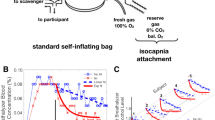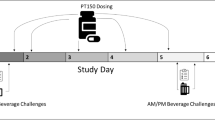Abstract
Background
Infants in the neonatal intensive care unit may be exposed to ethanol via medications that contain ethanol as an excipient and through inhalation of ethanol vapor from hand sanitizers. We hypothesized that both pathways of exposure would result in elevated urinary biomarkers of ethanol.
Methods
Urine samples were collected from infants in incubators and in open cribs. Two ethanol metabolites, ethyl sulfate (EtS) and ethyl glucuronide (EtG), were quantified in infants’ urine.
Results
A subset of infants both in incubators and open cribs had ethanol biomarkers greater than the cutoff concentration that identifies adult alcohol consumption. These concentrations were associated with the infant having received an ethanol-containing medication on the day of urine collection. When infants who received an ethanol-containing medication were excluded from analysis, there was no difference in ethanol biomarker concentrations between the incubator and crib groups.
Conclusions
Some infants who received ethanol-containing medications had concentrations of ethanol biomarkers that are indicative of adult alcohol consumption, suggesting potential exposure via ethanol excipients.
Impact
-
Infants and newborns in the neonatal intensive care unit are exposed to concerning amounts of ethanol.
-
No one has shown exposure to ethanol in these infants before this study.
-
The impact is that better understanding of the excipients in medications given to patients in the NICU is needed. When physicians order medications in the NICU, the amount of excipient needs to be indicated.
Similar content being viewed by others
Log in or create a free account to read this content
Gain free access to this article, as well as selected content from this journal and more on nature.com
or
References
Gupta, K. K., Gupta, V. K. & Shirasaka, T. An update on fetal alcohol syndrome—pathogenesis, risks, and treatment. Alcohol Clin Exp Res. 40, 1594–1602 (2016).
Jones, K. L., Smith, D. W., Ulleland, C. N. & Streissguth, P. Pattern of malformation in offspring of chronic alcoholic mothers. Lancet 1, 1267–1271 (1973).
Ikonomidou, C. et al. Ethanol-induced apoptotic neurodegeneration and fetal alcohol syndrome. Science (80−) 287, 1056–1060 (2000).
May, P. A. et al. Prevalence and epidemiologic characteristics of FASD from various research methods with an emphasis on recent in-school studies. Dev. Disabil. Res. Rev. 15, 176–192 (2009).
Williams, J. F., Smith, V. C. & ABUSE, C. O. N. S. Fetal alcohol spectrum disorders. Pediatrics 136, e1395–e1406 (2015).
Chang, G. Screening and brief intervention in prenatal care settings. Alcohol Res. Health 28, 80–84 (2004).
Moreno, M. Prenatal alcohol exposure: no safe amount. JAMA Pediatrics 171, 820 (2017).
Bouyssi-Kobar, M. et al. Third trimester brain growth in preterm infants compared with in utero healthy fetuses. Pediatrics 138, e20161640 (2016).
Nakhoul, M., Seif, K., Haddad, N. & Haddad, G. Fetal alcohol exposure: the common toll. J. Alcohol Drug Depend. 5, 257 (2017).
Hsieh, S., Sapkota, A., Wood, R., Bearer, C. & Kapoor, S. Neonatal ethanol exposure from ethanol-based hand sanitisers in isolettes. Arch. Dis. Child Fetal Neonatal Ed. 103, F55–F58 (2018).
Boor, B. E., Jarnstrom, H., Novoselac, A. & Xu, Y. Infant exposure to emissions of volatile organic compounds from crib mattresses. Environ. Sci. Technol. 48, 3541–3549 (2014).
Scheuplein, R., Charnley, G. & Dourson, M. Differential sensitivity of children and adults to chemical toxicity. I. Biological basis. Regul. Toxicol. Pharmacol. 35, 429–447 (2002).
Abraham, K., Mielke, H., Huisinga, W. & Gundert-Remy, U. Elevated internal exposure of children in simulated acute inhalation of volatile organic compounds: effects of concentration and duration. Arch. Toxicol. 79, 63–73 (2005).
Pikkarainen, P. H. & Räihä, N. C. R. Development of alcohol dehydrogenase activity in the human liver. Pediatr. Res. 1, 165–168 (1967).
Benedetti, M. S., Whomsley, R. & Canning, M. Drug metabolism in the paediatric population and in the elderly. Drug Discov. Today. 12, 599–610 (2007).
Tran, M. N., Wu, A. H. B. & Hill, D. W. Alcohol dehydrogenase and catalase content in perinatal infant and adult livers: potential influence on neonatal alcohol metabolism. Toxicol. Lett. 169, 245–252 (2007).
Akinmboni, T. O., Davis, N. L., Falck, A. J., Bearer, C. F. & Mooney, S. M. Excipient exposure in very low birth weight preterm neonates. J. Perinatol. 38, 169–174 (2018).
El-Metwally, D. et al. Urinary metabolites of volatile organic compounds of infants in the neonatal intensive care unit. Pediatr. Res. 83, 1158–1164 (2018).
Schloegl, H. et al. Stability of ethyl glucuronide in urine, post-mortem tissue and blood samples. Int. J. Legal Med. 120, 83–88 (2006).
Himes, S. K., Concheiro, M., Scheidweiler, K. B. & Huestis, M. A. Validation of a novel method to identify in utero ethanol exposure: simultaneous meconium extraction of fatty acid ethyl esters, ethyl glucuronide, and ethyl sulfate followed by LC-MS/MS quantification. Anal. Bioanal. Chem. 406, 1945–1955 (2014).
Bakhireva, L. N. et al. Prenatal alcohol exposure prevalence as measured by direct ethanol metabolites in meconium in a Native American tribe of the southwest. Birth Defects Res. 111, 53–61 (2019).
Team R. R: A Language and Environment for Statistical Computing (R Development Core Team, 2013).
Armer, J. M. & Allcock, R. L. Urine ethyl glucuronide and ethyl sulphate using liquid chromatography-tandem mass spectrometry in a routine clinical laboratory. Ann. Clin. Biochem. 54, 60–68 (2017).
Graham, A. E., Beatty, J. R., Rosano, T. G., Sokol, R. J. & Ondersma, S. J. Utility of commercial ethyl glucuronide (EtG) and ethyl sulfate (EtS) testing for detection of lighter drinking among women of childbearing years. J. Stud. Alcohol. Drugs 78, 945–948 (2017).
Committee on Drugs. Ethanol in Liquid Preparations Intended for Children. Pediatrics. 73, 405–407 (1984).
Reisfield, G. M. et al. Ethyl glucuronide, ethyl sulfate, and ethanol in urine after sustained exposure to an ethanol-based hand sanitizer. J. Anal. Toxicol. 35, 85–91 (2011).
Jatlow, P. I. et al. Ethylglucuronide and ethyl sulfate assays in clinical trials, interpretation and limitations: results of a dose ranging alcohol challenge study and two Clinical trials. Alcohol. Clin. Exp. Res. 38, 2056–2065 (2014).
Tayman, C., Rayyan, M. & Allegaert, K. Neonatal pharmacology: extensive interindividual variability despite limited size. J. Pediatr. Pharmacol. Ther. 16, 170–184 (2011).
Marek, E. & Kraft, W. K. Ethanol pharmacokinetics in neonates and infants. Curr. Ther. Res. Clin. Exp. 76, 90–97 (2014).
Whittaker, A. et al. Toxic additives in medication for preterm infants. Arch. Dis. Child. Fetal Neonatal Ed. 94, F236–F240 (2009).
Lass, J. et al. Hospitalised neonates in Estonia commonly receive potentially harmful excipients. BMC Pediatr. 12, 136 (2012).
Nellis, G. et al. Potentially harmful excipients in neonatal medicines: a pan-European observational study. Arch. Dis. Child. 100, 694–699 (2015).
Garcia-Palop, B., Movilla Polanco, E., Cañete Ramirez, C. & Cabañas Poy, M. J. Harmful excipients in medicines for neonates in Spain. Int. J. Clin. Pharm. 38, 238–242 (2016).
Soremekun, R., Ogbuefi, I. & Aderemi-Williams, R. Prevalence of ethanol and other potentially harmful excipients in pediatric oral medicines: survey of community pharmacies in a Nigerian City. BMC Res. Notes 12, 460 (2019).
Zuccotti, G. V. & Fabiano, V. Safety issues with ethanol as an excipient in drugs intended for pediatric use. Exp. Opin. Drug Saf. 10, 499–502 (2011).
Bearer, C. F., Bailey, S. M. & Hoek, J. B. Advancing alcohol biomarkers research. Alcohol. Clin. Exp. Res. 34, 941–945 (2010).
Acknowledgements
This work was supported in part by the University of Maryland, School of Pharmacy Mass Spectrometry Center (SOP1841-IQB2014).
Author information
Authors and Affiliations
Contributions
M.P.S. participated in the acquisition of data, performed all data analysis and interpretation, drafted the article and gave final approval of version submitted. F.A.-M. participated in the acquisition of data, revised the manuscript critically and gave final approval of version submitted. D.E.-M. participated in the study design, preliminary data analysis, revising the manuscript critically for important intellectual content, and gave final approval of version submitted. J.W.J. performed sample analysis, critically reviewed the manuscript and gave final approval of version submitted. M.A.K. oversaw sample analysis, critically reviewed the manuscript and gave final approval of version submitted. C.F.B. made substantial contributions to conception and design of the project, interpretation of the data, revised the manuscript critically for intellectual content and gave final approval of version submitted.
Corresponding author
Ethics declarations
Competing interests
The authors declare no competing interests.
Additional information
Publisher’s note Springer Nature remains neutral with regard to jurisdictional claims in published maps and institutional affiliations.
Rights and permissions
About this article
Cite this article
Stefanak, M.P., Al-Mudares, F., El-Metwally, D. et al. High concentrations of urinary ethanol metabolites in neonatal intensive care unit infants. Pediatr Res 88, 865–870 (2020). https://doi.org/10.1038/s41390-020-1020-5
Received:
Revised:
Accepted:
Published:
Issue date:
DOI: https://doi.org/10.1038/s41390-020-1020-5
This article is cited by
-
Ethanol metabolites increase over time in preterm infants receiving ethanol containing medications: a concern
Pediatric Research (2025)
-
Peripheral blood transcriptomic profiling of molecular mechanisms commonly regulated by binge drinking and placebo effects
Scientific Reports (2024)
-
Commentary: …And a beer for the baby, please
Pediatric Research (2020)



